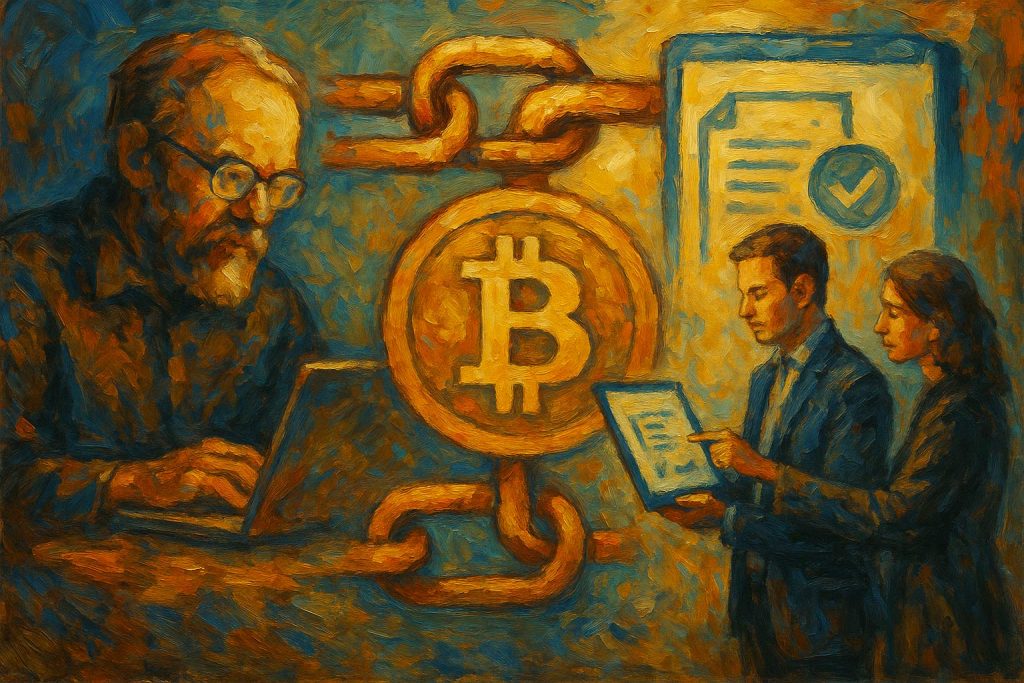The Ledger That Wouldn’t Lie
Long before blockchain became a buzzword plastered across banking reports and venture-capital decks, it was a quiet rebellion brewing in the corners of the internet. In the early 1990s, a loose network of cryptographers, economists, and iconoclasts began asking a question that most people never thought to ask: Why should money belong to the state?
They weren’t libertarians with placards or economists with spreadsheets. They were cypherpunks — coders, mathematicians, and dreamers who saw the internet not just as a tool for communication, but as the scaffolding for a new kind of society. To them, privacy was not paranoia; it was a human right. Trust in institutions was not a given; it was a vulnerability. And money, the very bloodstream of the economy, was too important to be left in the hands of politicians, central banks, or corporate treasurers.
The mainstream ignored them. The financial press didn’t cover them. Yet in mailing lists and late-night IRC chats, they began sketching the outlines of something extraordinary: a public ledger that no government could alter, no corporation could own, and no single person could corrupt.
For years, it remained a utopian blueprint — untested, incomplete, and technically fragile. Then came 2008. The global financial system convulsed. Banks collapsed. Governments rushed to print money to prop them up. The very trust that had underpinned fiat currency cracked open. And into that breach stepped an anonymous figure, Satoshi Nakamoto, with nine pages of dense code and a promise that sounded like heresy: We can build money without masters.
The Cypherpunk Dream
To understand blockchain’s genesis, you must step away from Silicon Valley’s glass towers and into the dim glow of early internet forums, where anonymity wasn’t a shield for trolling but a prerequisite for freedom.
The cypherpunks — a loosely organised tribe of programmers, mathematicians, and political thinkers — coalesced in the late 1980s and early 1990s around a single conviction: that cryptography could be a tool of personal liberation. Figures like Timothy C. May, Eric Hughes, and John Gilmore were not building apps for investors; they were building an ideology. Hughes’s A Cypherpunk’s Manifesto (1993) distilled their mission into a rallying cry: “Privacy is necessary for an open society in the electronic age.”
They weren’t content to debate theory. They wrote code. Phil Zimmermann’s Pretty Good Privacy (PGP) gave ordinary people military-grade encryption for their emails. David Chaum — the godfather of digital cash — proposed ecash, an anonymous, cryptographically secure currency that would allow payments without banks. Chaum’s DigiCash company, founded in 1989, was the first true attempt at internet money. It failed commercially, but its architecture would echo through every digital currency that came after.
For the cypherpunks, money was the final frontier. Email encryption protected speech. Digital cash, they believed, would protect economic freedom. But building it was another matter entirely. Early experiments like Wei Dai’s ‘b-money’ and Nick Szabo’s ‘bit gold’ outlined systems for decentralised money, but none solved the “double-spending problem” — the ability to spend the same unit of currency twice without central oversight. Without that breakthrough, digital cash was destined to remain a noble failure.
Throughout the 1990s and early 2000s, the cypherpunk dream remained just that: a dream. The dot-com boom came and went. The internet commercialised. And while governments and corporations adopted stronger encryption to protect their own interests, the vision of a people-powered, borderless currency seemed to recede into the shadows.
Yet the mailing lists stayed alive. The conversations never stopped. And in October 2008, when the world’s financial system was still reeling from its near collapse, a new name appeared on the Cryptography Mailing List: Satoshi Nakamoto. The subject line read, simply: Bitcoin P2P e-cash paper.
Satoshi’s Gambit
The email landed quietly on Halloween Night October 31, 2008 in the inboxes of the Cryptography Mailing List. No fanfare, no corporate logo, no slick PDF. Just a link to a nine-page paper and a modest introduction from an unfamiliar name: Satoshi Nakamoto. The paper’s title was clinical, almost forgettable: Bitcoin: A Peer-to-Peer Electronic Cash System.
At first glance, it read like another in a long line of theoretical proposals. But buried in those dense pages was a breakthrough the cypherpunks had been chasing for decades: a way to achieve consensus in a decentralised network without trusting a central authority. Satoshi’s insight was deceptively simple — combine cryptographic proof-of-work with a distributed, timestamped ledger, so that the history of transactions would be immutable and transparent to all.
Hal Finney, one of the most respected cryptographers in the community, responded within hours. He ran the software, mined the first blocks, and received the first-ever Bitcoin transaction from Satoshi — a transfer of 10 BTC on January 12, 2009. Finney would later describe those early days as “playing with a new toy,” but for the small circle who understood the code’s implications, it was something closer to alchemy: turning mathematics into money.
The first months of Bitcoin’s life were almost monastic. Satoshi and a handful of early adopters — Finney, Wei Dai, Nick Szabo, and others — mined blocks on their home computers. The “network” was a few dozen nodes. Each coin was worth fractions of a cent. Yet the ledger was alive. Every 10 minutes, a new block appeared, proof that the system worked exactly as promised.
Then came Bitcoin Pizza Day — May 22, 2010 — when Florida programmer Laszlo Hanyecz paid 10,000 BTC for two Papa John’s pizzas, arranged via an online forum. At the time, the coins were worth about $41. Today, they’d be worth hundreds of millions. The transaction became lore — both as a punchline and as a marker of legitimacy. Bitcoin had crossed the membrane between theory and the real economy.
By then, Satoshi had already begun to fade from view. In April 2011, after a final round of correspondence, they handed control of the code repository to developer Gavin Andresen and disappeared. No public appearances. No face. Just a trail of forum posts, emails, and code commits. To this day, no one knows who Satoshi was — a single genius, a pseudonymous collective, or perhaps both. Their absence has only deepened Bitcoin’s mythos, leaving the project leaderless yet strangely unassailable.
Bitcoin’s existence was no longer a question. The question now was: what would it become?
The Ethereum Revolution: From Digital Gold to the World Computer
By 2014, Bitcoin had survived its first speculative bubble and existential scandals, but its scope remained narrow. It was elegant for moving value, yet clumsy for doing anything else. Transactions could be verified, but their purpose was fixed: sending and receiving Bitcoin. For a new generation of developers, this limitation felt like building the internet where every webpage could only send email.
One of those developers was a young Russian Canadian programmer named Vitalik Buterin. At just nineteen, Buterin was already a prominent voice in the Bitcoin community, co-founding Bitcoin Magazine and contributing to its technical discourse. But he was frustrated by Bitcoin’s rigidity. Why, he asked, couldn’t the blockchain serve as a programmable foundation — not just for money, but for any decentralised application?
In late 2013, Buterin published the Ethereum white paper, outlining a radical vision: a “world computer” powered by a decentralised network, capable of executing “smart contracts” — self-enforcing agreements written in code. These contracts wouldn’t need lawyers, courts, or corporate intermediaries. They would run automatically, exactly as programmed, on a blockchain that anyone could verify and no one could unilaterally control.
The idea caught fire. A crowdfunding campaign in mid-2014 raised over $18 million in Bitcoin — then the largest in crypto history — and brought together a team of developers, including Gavin Wood, who would later formalise Ethereum’s programming language Solidity, and Joseph Lubin, who would go on to found ConsenSys, a major blockchain incubator.
Ethereum launched in July 2015, and almost immediately it expanded the cultural and technical horizons of blockchain. Decentralised apps (dApps) began to appear, ranging from prediction markets to experimental governance systems. Initial Coin Offerings (ICOs) emerged as a new fundraising mechanism, allowing anyone with an internet connection to back a project — though not without rampant speculation and scams that echoed the Wild West ethos of Bitcoin’s early days.
But Ethereum’s real breakthrough was philosophical. If Bitcoin was “digital gold” — static, resistant to change, a store of value — Ethereum was a living, breathing operating system. It was the first proof that blockchain could be more than a ledger of past transactions; it could be an engine for future possibilities.
This shift also reframed the decentralisation debate. Ethereum wasn’t trying to replace money alone; it was challenging the entire infrastructure of trust in modern society. Banks, stock exchanges, voting systems, copyright registries, even social networks — all could, in theory, be rebuilt on blockchain rails, with transparency and censorship-resistance baked in.
It was a leap that even many cypherpunks had not dared to imagine in the 1990s. And it was one that would set the stage for both the explosive creativity — and the ethical dilemmas — of the blockchain era to come.
The ICO Gold Rush: Boom, Bust, and the Lessons of 2017–2018
Ethereum’s promise of programmable contracts didn’t just inspire developers — it ignited a financial frenzy. By 2017, the term Initial Coin Offering (ICO) had entered the global vocabulary. Unlike a traditional IPO, which required regulatory approval, legal disclosures, and underwriting by investment banks, an ICO allowed a project to raise capital simply by issuing a token on the blockchain and selling it directly to the public.
The appeal was obvious. For entrepreneurs, ICOs removed the gatekeepers of traditional finance; anyone could raise millions without pitching to venture capitalists or listing on a stock exchange. For investors or speculators it was a new gold rush. With a few clicks and some Ether in a digital wallet, they could buy into projects promising to reinvent industries: decentralised cloud computing, blockchain-based healthcare, tokenised art markets.
The money poured in. In 2017 alone, ICOs raised over $6 billion globally, according to CoinDesk’s data. High-profile sales like Filecoin attracted over $200 million in funding, while smaller projects raised tens of millions in hours — sometimes minutes. A spirit of techno-utopianism gripped the market. To many, this was the democratisation of investment: no brokers, no borders, just blockchain.
But under the surface, the cracks were obvious. Some projects were driven more by marketing than by code. White papers — often little more than buzzword-laden PDFs — promised revolutionary technology without a working prototype. Inexperienced teams handled millions in funds without governance safeguards. And in some cases, outright fraud flourished. One infamous ICO, PlexCoin, raised $15 million before regulators shut it down as a Ponzi scheme.
By early 2018, reality began to bite. Regulatory bodies like the U.S. Securities and Exchange Commission (SEC) and the UK’s Financial Conduct Authority (FCA) signalled that many ICOs were unregistered securities offerings. The market overheated, fuelled by speculative buying and “fear of missing out” (FOMO), and then collapsed. Token prices plummeted. According to a study by Boston College, more than 50% of ICOs had failed within four months of fundraising.
Yet the ICO boom was not simply a cautionary tale. It marked a turning point in blockchain’s evolution, showing both the potential and peril of decentralised finance. It demonstrated that blockchain could unlock entirely new funding mechanisms, enabling global participation at unprecedented speed — but also that without accountability, transparency, and legal clarity, trust could evaporate just as quickly as it was created.
The lessons of the ICO era still resonate today in the rise of more regulated models such as Security Token Offerings (STOs) and Initial Exchange Offerings (IEOs), as well as in decentralised finance (DeFi) protocols that build investor protections directly into their smart contracts. The ICO years were blockchain’s adolescence — exuberant, experimental, and reckless — and they forced the industry to confront a difficult truth: code alone cannot guarantee fairness. Human governance still matters.
From Speculation to Systems: The Rise of DeFi and NFTs
If the ICO era was blockchain’s adolescence, Decentralised Finance (DeFi) marked the first steps into adulthood — though still with a teenager’s appetite for risk. Emerging in earnest around 2019, DeFi leveraged Ethereum’s smart contracts not to launch speculative tokens, but to replicate and reimagine core functions of the traditional financial system: lending, borrowing, trading, and earning interest.
The principle was radical in its simplicity: remove banks, brokers, and other intermediaries, and replace them with code. On DeFi platforms like Uniswap, users could trade cryptocurrencies directly with one another via automated liquidity pools, without needing a central exchange. Protocols such as Aave and Compound allowed people to lend their crypto assets to others and earn interest in real time, with loans secured by smart contract collateral rather than human underwriters.
By 2021, DeFi’s total value locked — the measure of how much crypto was deposited into its protocols — surpassed $100 billion, according to DeFi Pulse. The appeal was obvious: higher yields than traditional savings accounts, global access without a credit check, and transparency built into the very architecture of the system. Yet the risks were equally real. Smart contract bugs led to multi-million-dollar exploits. Price manipulation in illiquid markets caused “flash loan” attacks. And the lack of regulatory clarity left users with little recourse when things went wrong.
While DeFi reengineered finance, Non-Fungible Tokens (NFTs) reimagined culture. In 2021, NFT sales exploded, transforming blockchain from an abstract financial experiment into a mainstream cultural phenomenon. Unlike cryptocurrencies, NFTs represented unique digital items — art, music, videos, even moments in sports — verifiable on the blockchain as one-of-a-kind assets.
Projects like CryptoPunks and Bored Ape Yacht Club became status symbols, selling for hundreds of thousands or even millions of dollars. The artistBeeple made headlines when his digital collage Everydays: The First 5000 Days sold at Christie’s for $69 million, marking the first time a major auction house embraced purely digital art. For creators, NFTs offered something revolutionary: the ability to sell directly to audiences without galleries, record labels, or publishing houses — and to embed royalties in the smart contract, ensuring they earned from every future resale.
Yet, as with ICOs, the gold rush carried its own distortions. The hype drove speculative flipping, with many buyers treating NFTs less as art or collectibles and more as lottery tickets. Critics questioned the environmental cost of proof-of-work blockchains used for minting, while others pointed to market saturation and plagiarism, as anyone could mint an NFT of stolen artwork.
Still, DeFi and NFTs expanded the blockchain narrative beyond finance. They showed how distributed ledgers could underwrite entire ecosystems — not just money, but culture, creativity, and community. Where ICOs hinted at decentralised capital formation, DeFi proved decentralised markets could function without middlemen, and NFTs proved digital scarcity could have emotional and economic value.
These developments also set the stage for the next frontier: the metaverse, Web3 governance, and blockchain’s integration into the physical world — from supply chains to digital identity.
The Layer 1 Wars: Scaling the Dream
By the time DeFi and NFTs had captured global attention, Ethereum was both the star and the bottleneck of the blockchain world. Its smart contract functionality had become the default infrastructure for innovation — but success had brought congestion. Transactions that once cost pennies now spiked to over $100 during periods of high demand, and confirmation times slowed to a crawl. For a movement that promised accessibility and inclusivity, this was a glaring contradiction.
The problem was architectural. Ethereum’s proof-of-work consensus, inherited from Bitcoin, was secure but slow, processing roughly 15 transactions per second. Visa, by comparison, could handle thousands. For Ethereum to scale without compromising decentralisation, it would need either radical upgrades or competition from faster blockchains.
Enter the Layer 1 wars. Projects like Binance Smart Chain (BSC), Solana, Avalanche, and Algorand emerged with the promise of higher throughput, lower fees, and developer-friendly ecosystems. Solana boasted speeds of up to 65,000 transactions per second, with near-instant finality. Avalanche offered sub-second transaction times and a novel consensus model. Binance Smart Chain leaned into pragmatism — fewer validators, more centralisation — but in exchange, fees were negligible and user adoption soared.
Each contender pitched itself as the answer to Ethereum’s limitations, and in some ways, they were. NFT marketplaces flourished on Solana. DeFi protocols migrated to Avalanche to escape Ethereum’s high fees. Play-to-earn blockchain games like Axie Infinity chose Ronin, a specialised sidechain, to support millions of daily transactions without Ethereum’s bottlenecks.
Ethereum, however, was not idle. The community pressed ahead with Ethereum 2.0, a multi-year upgrade replacing proof-of-work with proof-of-stake, drastically reducing energy consumption and laying the groundwork for sharding — splitting the blockchain into parallel chains to scale throughput. This culminated in The Merge of September 2022, a historic event in which Ethereum transitioned to proof-of-stake without halting the network, a feat compared by some developers to “changing the engine of a jet mid-flight.”
The Layer 1 competition was not just a technological race. It reflected deeper philosophical divides in the blockchain community. Should speed and low fees be prioritised even if it meant fewer validators and greater centralisation? Or should the principles of trustlessness and censorship resistance outweigh the pressures of mass adoption?
By the mid-2020s, it was clear no single blockchain would “win” outright. Instead, an increasingly interconnected ecosystem began to form, linked by cross-chain bridges and Layer 2 solutions like Polygon, Optimism, and Arbitrum. The future was no longer just about one chain ruling them all, but about an internet of blockchains, each optimised for different use cases, yet interoperable through shared protocols.
The wars had reshaped the map of the crypto landscape. Ethereum remained the cultural and developer hub. Solana and Avalanche had carved niches in gaming and DeFi. Binance Smart Chain captured the retail trader. And Bitcoin, still plodding along in its minimalist way, had quietly found new purpose in being “digital gold,” the base reserve of the crypto economy.
From here, blockchain’s story would begin to merge with something larger — the rise of Web3 as a cultural and economic paradigm, and the reimagining of the internet itself.
Web3: From Currency to Culture
By the time the Layer 1 wars settled into a fragile coexistence, a new narrative began to take shape. Blockchain was no longer just a tool for alternative money or speculative finance — it was being reframed as the backbone of a new internet. This vision had a name: Web3.
The term wasn’t entirely new. Gavin Wood, Ethereum’s co-founder, first used it in 2014 to describe an internet where users owned their data, identities, and digital assets, without having to trust centralised intermediaries. But in the post-NFT, post-DeFi boom, “Web3” took on a broader cultural momentum. Venture capitalists, artists, musicians, and even politicians began speaking its language.
Where Web1 had been the static internet of websites, and Web2 the interactive but centralised world of platforms like Facebook, YouTube, and Twitter, Web3 promised a participatory internet in which ownership was programmable and governance was transparent. You wouldn’t just post content; you could tokenise it, sell it, fractionalise it, and govern it collectively with others.
In practice, this meant DAOs (Decentralised Autonomous Organisations) replacing corporate boards. It meant decentralised social networks like Lens Protocol or Farcaster trying to unseat the platform monopolies of Web2. It meant experiments in community-driven finance — from tokenised cities like CityDAO in Wyoming to crowdfunded film production on Ethereum.
For some, Web3 was liberation — a way to rebuild the internet without the advertising chokehold and algorithmic manipulations of Big Tech. For others, it was a Trojan horse for new forms of speculation, prone to the same inequality and hype cycles as the broader crypto world. Critics noted that many early Web3 projects were still heavily dependent on centralised infrastructure, from cloud hosting to VC-backed governance tokens, raising uncomfortable questions: if the tools of Web3 were built by the same actors who profited most from Web2, was this really a revolution or just rebranding?
Yet the experiments kept coming. In 2021, the group ConstitutionDAO raised over $40 million in Ethereum in a matter of days to bid on a rare copy of the U.S. Constitution — losing the auction but proving that mass-scale crowdfunding on blockchain was not only possible, but culturally magnetic. In the Philippines, the play-to-earn model of Axie Infinitybriefly became a source of income for tens of thousands, showing both the potential and pitfalls of blockchain-powered labour markets.
Web3 was as much about rethinking trust as it was about rethinking technology. In a world shaken by institutional failures — from the 2008 financial crisis to the COVID-19 pandemic’s supply chain breakdowns — the idea of systems where rules were enforced by code rather than human discretion had undeniable appeal.
But the cultural leap was bigger than the technical one. Moving from an internet where the user is the product to one where the user is the owner meant re-educating millions on concepts like private keys, wallet security, and decentralised governance. It meant confronting the reality that trustlessness has a cost: when there is no central authority to reset your password, there is also no one to save you from your own mistakes.
By the mid-2020s, Web3 was not a finished reality but an evolving proposition — a set of tools and principles in search of mass adoption. It had seeded movements in art, finance, media, and gaming. It had pulled blockchain from the niche corners of finance into the cultural mainstream. And it had set the stage for the next phase: the collision between blockchain and the wider socio-political order, where the questions would no longer be about scalability or tokenomics, but about power.
The Next Ledger: Society on Chain
From the cypherpunk manifestos of the 1990s to the sprawling Web3 experiments of the 2020s, the blockchain story has always been about more than code. It is about power — who holds it, who can challenge it, and how it can be redistributed in a world that has grown weary of gatekeepers.
The early pioneers saw money as the first domino. If you could build a currency outside state control, you could start reimagining the other pillars of society — identity, governance, media, trade. That vision is still unfinished, but each wave of innovation has moved the boundary of what seems possible. Bitcoin proved that decentralised value transfer could work at scale. Ethereum showed that programmable contracts could encode more than transactions — they could encode agreements, institutions, even communities.
Now, the questions grow larger. What happens when governments adopt blockchain not to resist it, but to reinforce their own power? China’s digital yuan and Europe’s CBDC pilots hint at a future where blockchain may underpin centralised control rather than decentralised liberation. Will the dream of decentralisation survive if its tools are used by the very institutions it sought to bypass?
And yet, the same ledger that can enforce authoritarian precision can also enable unprecedented transparency. In supply chains, it can trace the origin of goods from cobalt mines to supermarket shelves. In elections, it can verify every vote without revealing the voter’s identity. In public finance, it can expose — in real time — how tax revenue is spent. The blockchain does not choose sides; it amplifies the intent of those who use it.
If there is a constant through this history, it is the tension between trust and truth. Fiat currency runs on trust in institutions; blockchain runs on the verifiable truth of cryptography. One bends to political necessity; the other is bound to mathematical finality. Neither is inherently good or bad — both are shaped by human choices.
As the technology matures, its cultural challenge will be the same as its technical one: to embed decentralised systems into the rhythms of everyday life without losing sight of the values that made them worth building in the first place. That means resisting the temptation to let decentralisation become a marketing slogan, ensuring that the next generation of protocols are as open in governance as they are in code.
The story is not over. We may still be in blockchain’s dial-up era, the equivalent of the early web when most people dismissed the internet as a fad for hobbyists. The eventual shape of this technology — whether it becomes the infrastructure of a freer, more equitable society or another layer of corporate and state control — will depend not only on developers and entrepreneurs, but on educators, regulators, and citizens.
The ledger is ready. The blocks will keep coming, one after another, each sealed with the cryptographic certainty that first drew the cypherpunks to their keyboards. The only question is what kind of world we will choose to write into it.
By Pritish Beesooa, Head of Blockchain & Web3











